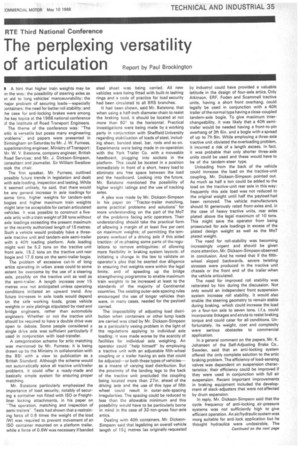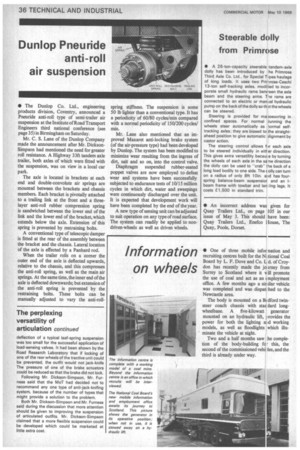The perplexing versatility
Page 37

Page 38

If you've noticed an error in this article please click here to report it so we can fix it.
of articulation Report by Paul Brockington
A hint that higher train weights may be m the way; the possibility of steering axles as 3n aid to long vehicles' manoeuvrability; the najor problem of securing loads—especially ;ontainers: the need for better roll stability; and :he case for anti-locking brakes were among :he key topics at the 1968 national conference 3f the Institute of Road Transport Engineers.
The theme of the conference was: ''The artic is versatile but poses many engineering 3roblems", and papers were presented in 3irmingham on Saturday by Mr. J. W. Furness, .3uperintending engineer, Ministry of Transport; Mr. W. V. Batstone, company engineer, British Road Services; and Mr. J. Dickson-Simpson, :.:onsultant and journalist. Sir William Swallow took the chair.
The first speaker, Mr. Furness, outlined possible future trends in legislation and dealt with axle loading, inspection and testing. While it seemed unlikely, he said, that there would be any general increase in axle loadings for some time, higher weights for tandem-axle bogies and higher maximum train weights might later be acceptable for certain articulated vehicles. It was possible to construct a fiveaxle artic with a train weight of 38 tons without axle loadings exceeding the present maximum or the recently authorized length of 15 metres. Such a vehicle would probably have a threeaxle tractive unit and tandem-axle semi-trailer with a 40ft loading platform. Axle loading might well be 5.2 tons on the tractive unit front axle, 15.2 tons on the tractive unit rear bogie and 17.6 tons on the semi-trailer bogie.
The problem of excessive cut-in of long artics operating in urban areas could to some extent be overcome by the use of a steering axle, possibly on the tractive unit as well as the semi-trailer. A length increase over 15 metres was not anticipated unless operating conditions initiated an upward trend. Any future increases in axle loads would depend on the safe working loads, gross vehicle weights or axle platings stipulated by road and bridge engineers, rather than automobile engineers. Whether or not the tractive unit should be required to have a double drive was open to debate. Some people considered a single drive axle was sufficient particularly if used in conjunction with load-transfer.
A categorization scheme for artic matching was mentioned by Mr. Furness; it is being drawn up by the Ministry in collaboration with the BSI with a view to publication as a British Standard. Although the scheme would not automatically solve all tractive unit/trailer problems, it could offer a ready-made and basically simple system for ensuring proper matching.
Mr. Batstone particularly emphasized the importance of load security, notably of secur ing a container not fitted with ISO or Freightliner locking attachments, in his paper on "The operation, matching and inspection of semi-trailers". Tests had shown that a restraining force of 0.8 times the weight of the load (W) was required to prevent movement of an ISO container mounted on a platform trailer, while a force of 0.6W was necessary if banded steel sheet was being carried. All new vehicles were being fitted with built-in lashing rings and a code of practice for load security had been circulated to all BRS branches.
It had been shown, said Mr. Batstone, that when using a half-inch diameter chain to resist the braking load, it should be located at not more than 60° to the horizontal. Practical investigations were being made by a working party in conjunction with Sheffield University regarding stabilization of loads of steel, including sheet, banded steel, bar, rods and so on. Experiments were being made in co-operation with the York Trailer Co. with a moveable headboard, plugging into sockets in the platform. This could be located in a position immediately in front of a short, heavy load to eliminate any free space between the load and the headboard. Looking into the future, Mr. Batstone mentioned the possibility of higher weight ratings and the use of tracking axles.
A plea was made by Mr. Dickson-Simpson in his paper on "Tractor-trailer matching, some practical problems and solutions" for more understanding on the part of the MoT of the problems facing artic operators. Their understanding should take the practical form of allowing a margin of at least five per cent on maximum weights; of permitting the tem porary overload of a driving axle if this aided traction: of re-phasing some parts of the regulations to remove ambiguities; of allowing more flexibility in braking system layouts: of initiating a change in the law to validate an operator's plea that he exerted due diligence in ensuring that weights were within the legal limits; and of speeding up the bridge strengthening programme to enable maximum train weights to be increased at least to the standards of the majority of Continental countries. The existing outer-axle spacing rules encouraged the use of longer vehicles than were, in many cases, needed for the payload carried.
The impossibility of adjusting load distribution when containers or other lump loads are carried was cited by Mr. Dickson-Simpson as a particularly vexing problem in the light of the regulations applying to individual axle loading; it was made worse by the scarcity of facilities for individual axle weighing. An operator could "help himself" by employing a tractive unit with an adjustable fifth-wheel
coupling or a trailer having an axle that could be adjusted—or both these types of vehicles—
as a means of varying load distribution. But the proximity of the landing legs to the back of the tractive unit precluded the coupling being located more than 27in. ahead of the driving axle and the use of this type of fifth wheel could result in outer-axle-spacing irregularities. The spacing could be reduced to less than the allowable minimum and this possibility would have to be particularly borne in mind in the case of 32-ton-gross four-axle artics.
Dealing with 40ft containers. Mr. DicksonSimpson said that legalizing an overall vehicle length of 15,1 metres (as originally requested by industry) could have provided a valuable latitude in the design of four-axle artics. Only Atkinson, ERF, Foden and Scammell tractive units, having a short front overhang, could legally be used in conjunction with a 40ft trailer of the normal type having a close-coupled tandem-axle bogie. To give maximum interchangeability, it was likely that a 40ft semitrailer would be needed having a front-to-pin overhang of 3ft 61n. and a bogie with a spread of up to 7ft 9in. While employing a three-axle tractive unit obviated the overloading problem, it incurred a risk of a length excess. In fact, it was probable that only shorter three-axle units could be used and these would have to be of the tandem-steer type.
Unloading from the back of the vehicle could increase the load on the tractive-unit coupling, Mr. Dickson-Simpson pointed out. As much as half a ton could be added to the load on the tractive-unit rear axle in this way; frequently this axle load was not reduced to the original weight until half the payload had been removed. The vehicle manufacturers should fit generously rated front-axles and, in the case of heavy tractive units, rear axles plated above the legal maximum of 10 tons. This might save the operator from being prosecuted for axle loadings in excess of the plated design weight as well as the MoT plated weight.
The need for roll-stability was becoming increasingly urgent and should be given more attention, Mr. Dickson-Simpson observed in conclusion. And he noted that if the fifthwheel sloped backwards, severe twisting stresses were produced in the tractive unit chassis or the front end of the trailer when the vehicle articulated.
The need for improved roll stability was reiterated by him during the discussion. Not only would an independent front suspension system increase roll stability, it would also enable the steering geometry to remain stable during braking, which could increase the load on a four-ton axle to seven tons. I.f.s, could incorporate linkages and struts to resist braking torque and could cater for all conditions. Unfortunately, its weight, cost and complexity were serious obstacles to commercial application.
In a general comment on the papers, Mr. K. Johansen of the Self-Adjusting Brake Co., Sweden, said that an anti-locking system offered the only complete solution to the artic braking problem. The efficiency of load-sensing valves was dependent on suspension characteristics; their efficiency could be improved if they were used in conjunction with full air suspension. Recent important improvements in braking equipment included the development of slack-adjusters that were notaffected by drum expansion.
In reply, Mr. Dickson-Simpson said that the cycle frequency of anti-locking air-pressure systems was not sufficiently high to give efficient operation. An air/hydraulic system was morg suitable for anti-lock application but he thought hydraulics were undesirable. The deflection of a typical leaf-spring suspension was too small for the successful application of load-sensing valves. It had been shown by the Road Research Laboratory that if locking of one of the rear wheels of the tractive unit could be prevented, the outfit would not jack-knife The pressure of one of the brake actuators could be reduced so that the brake did not lock.
Following Mr. Dickson-Simpson, Mr. Furness said that the MoT had decided not to recommend any one type of anti-jack-knifing system, because of the number of types that might provide a solution to the problem.
Both Mr. Dickson-Simpson and Mr. Furness said during the discussion that more attention should be given to improving the suspension of articulated outfits. Mr. Dickson-Simpson claimed that a more flexible suspension could be developed which could be marketed at little extra cost.












































































































